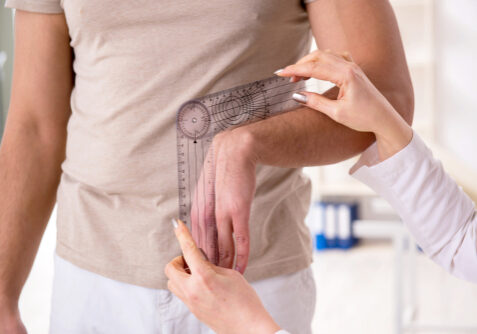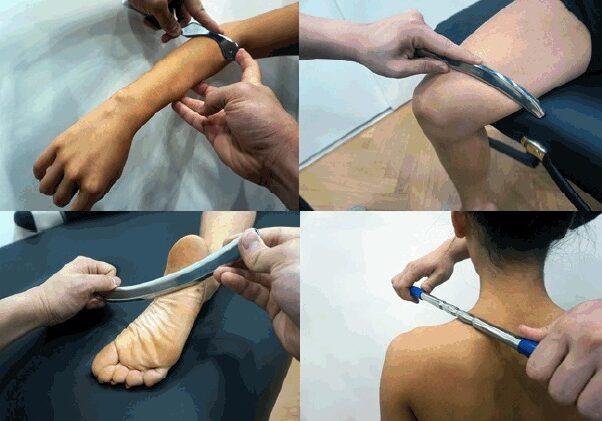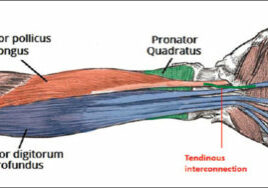J. F. Goubau, L. Goubau, A. Van Tongel, P. Van Hoonacker, D. Kerckhove, B. Berghs (2013).The wrist hyperflexion and abduction of the thumb (WHAT) test: a more specific and sensitive test to diagnose de Quervain tenosynovitis than the Eichhoff’s Test. J Hand Surg Eur Vol. 2014 Mar; 39(3): 286–292. Published online 2013 Jan 22. doi: 10.1177/1753193412475043
“The WHAT test is performed as follows: the wrist is hyperflexed and the thumb abducted in full MP and IP extension, resisted against the therapist’s index finger. Exacerbation of the symptomatology is considered a positive test result”.
The Skinny- When choosing a provocative test for De Quervain’s disease (De Quervain’s Tenosynovitis Test), therapists in the past have typically chosen from two popular tests; Eichoff’s test and Finkelstein’s test. The latter often being confused with the first. This study compares Eichoff’s test to a new test called The Wrist Hyperflexion and Abduction of the Thumb test (wrist hyperabduction test – WHAT). The study included 100 patients experiencing de Quervain tendinopathy between the years 2007-2010.
In The Weeds-Each patient underwent the Eichoff’s test and the WHAT test in random order by two experienced hand surgeons (test for de quervain’s tenosynovitis). Each provocative testing procedure was carried out in the same sequence to ensure consistency. Patients who tested positive under either test were sent for X-ray and ultrasonography to confirm the diagnosis of de Quervains.
Results: Ninety-three ultrasounds were positive and seven were negative. The accuracy of Eichoff’s test was .84 while the accuracy of the WHAT test was .94, suggesting that the latter performs better overall in establishing the correct diagnosis. The WHAT test also produced a better sensitivity at .99 and specificity at .29.
Bring it Home- A new test known as the WHAT test was developed due to the controversy associated with the accuracy of Eichoff’s test, and also the need for a more patient-friendly test for use in daily practice. This study found the WHAT test to be superior in all categories. This may be due in part to the specific mechanics of the WHAT test, positioning the anatomy in a way to accurately detect even the earliest symptoms.
This study was transparent about their methodology and had well thought out methods including sequence protocols for each provocative test for consistency, random order, and a large sample size. Using ultrasound technology to confirm the results of the in-clinic provocative testing provides a reliable diagnosis for comparison. Detailed explanations of the WHAT test were also provided along with pictures and illustrations of the anatomy, showing the superior mechanism of the test.
2 Comments
Leave a Reply Cancel Reply
More To Read
Hand Therapy as a New Grad or Student
Tips for Getting Prepared for hand therapy as a new grad or a Level II Fieldwork Everything you need to know in hand therapy starts with the upper extremity anatomy. Here is a quick checklist to review and hopefully help get you started in your new hand therapy setting. By: Tristany Hightower I suggest, as…
Read MoreWhat is the Effectiveness of IASTM?
Citation Kim, J., Sung, D. J., Lee, J. (2017). Therapeutic effectiveness of instrument-assisted soft tissue mobilization for soft tissue injury: Mechanisms and practical application. Journal of Exercise Rehabilitation, 13(1). doi: https://doi.org/10.12965/jer.1732824.412 The skinny IASTM is a relatively simple technique that uses the surface of an instrument to minimize the amount of pressure or force needed…
Read MoreA Fun Fact from a Hand Therapy Student
By: Ammie Ingwaldson Level 2 Fieldwork at a hand therapy clinic is a fast paced and continuous learning experience. The perfect example of this occurred last week while observing a therapist provide a client with their home CMC arthritis program. The therapist was educating the client on how to oppose their thumb to their small…
Read MoreSign-up to Get Updates Straight to Your Inbox!
Sign up with us and we will send you regular blog posts on everything hand therapy, notices every time we upload new videos and tutorials, along with handout, protocols, and other useful information.






I am looking forward to performing this test along with the Eichoff’s test. I think that if both are positive then it provides the physician with more information at their next MD appointment. I find that this diagnosis is often missed with my wrist sprain/strain patients.
Thank you for this information.
Nice post, I really appreciate you for sharing this informative post. Thanks